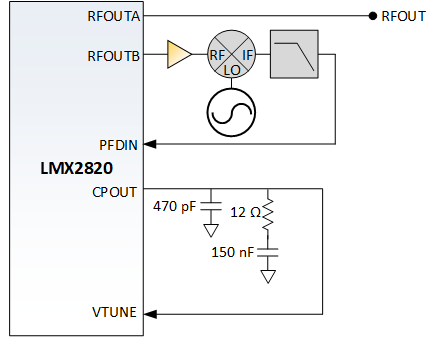SNAA361A april 2022 – may 2023 LMX2820
5 External PFD Topology
One of the main noise contributors in the PLL is the N-divider. For high-frequency applications, the N-divider must be fairly large to divide down to a more reasonable low-reference frequency. The external PFD approach uses an external mixer to bypass the internal N-divider. The RF mixer down-converts the VCO frequency to the PFD frequency directly. Of course, for there to be an improvement, the mixing operation must be inherently lower noise compared to the internal dividers. This requires the mixer LO to be low noise in itself. It may seem a bit contradictory to use the LMX2820 for generating a frequency tone that requires another frequency tone for an LO source. This is addressed in the subsequent section.
The TIDA-010230 reference design also provides an option to run with external PFD. Reference the block diagram in Figure 5-1. The output of the internal VCO is amplified and fed into the RF input of the mixer. Properly select the LO frequency to mix the VCO output down to the PFD frequency. The LMX2820 provides an external PFD divider to further reduce the frequency down to the reference if needed. Best performance is when this divider is bypassed (that is, kept at 1).
 Figure 5-1 Block Diagram of the External Mixer, PFD Topology
Figure 5-1 Block Diagram of the External Mixer, PFD TopologyAlthough this topology requires external circuitry and an additional LO source, it still uses the internal VCO. This allows the full range of the VCO to generate frequencies up to 22 GHz.